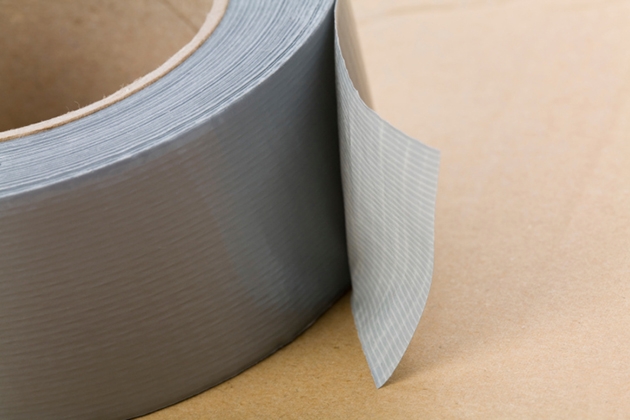One of those tools that has so many purposes is duct tape. The uses of duct tape are common, from removing warts to making a carbon-dioxide scrubber to keeping almost everything together. Not unexpectedly, in emergencies, duct tape has many possible applications and is a pillar for every survival kit. No wonder most preppers in their survival gear have at least a few duct tape rolls.
Here are 26 ways duct tape can be used in survival situations:
1: Bandages
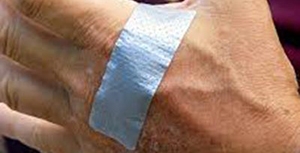

Any variety of bandages, including butterfly sutures, can be made with duct tape. Place a clean sheet of gauze or dressing on the sticky side of a piece of duct tape for major or larger wounds, and place the duct tape bandage over the wound. Cut two small strips of duct tape and position them perpendicular to the direction of the wound for injuries that involve keeping the wound closed.
2: Plug a leak in a small boat or canoe
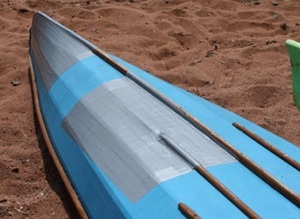

Due to the waterproof nature of duct tape, to make it usable, it can be put over a small crack or hole in a boat. The trick is to clean the surface of the hull very well, so that the duct tape can adhere as tightly as possible to the hull. Even, to have the best patch, position the duct tape on the inside and outside of the hull.
3: Rope substitute


Take a piece of duct that’s long enough to meet your needs for a rope. Twist it then so that it becomes a small rope.
This would likely be good enough for light duty work.
Create three chunks of duct tape rope for heavier applications, then braid them together.
4: Weatherstripping
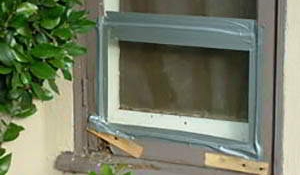

Duct tape is an effective means of closing water or air flow holes.
Duct tape can be used anywhere you might use caulk or weatherstripping.
5: Flagging tape substitute
Wrap some duct tape around a tree or a bush around eye level, instead of leaving a trail of breadcrumbs or spray-painting tree trunks. Although not the most reflective or colorful marker, a natural environment will stand out.
6: Arrow fletching
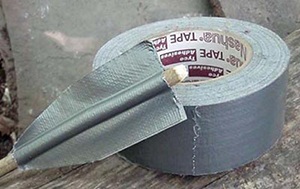

If you’re really roughing it to the point where making your own arrows is par for the course, two pieces of duct tape stuck together and cut to shape can substitute for feathers and provide the aerodynamic stability needed to make a reasonably accurate arrow.
Related: Do You Have These Bushcraft Skills?
7: Sealing openings in clothing
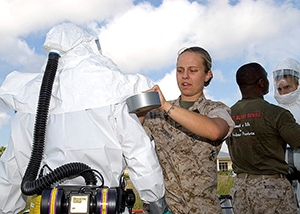

Duct tape can be wrapped around joints in your clothing, such where your boots meet your pants or gloves meet your sleeves, in order to seal them from the elements, chemicals or bugs.
Picture – >>> Duct tape used to seal decontamination suits.
8: Camouflage
No, the duct tape itself may not act as camouflage, but it can be put against your clothes by wrapping it around your body, sticky side out, and can make it possible to place leaves, grass, moss and small sticks to help break up the outline of your body.
Related: Camouflage for Preppers
9: Make a cast
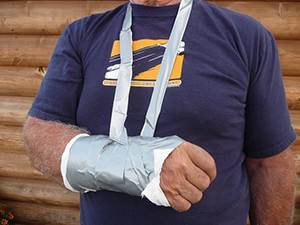

Although not a replacement for a medically set cast, any fractured bones or sprained joints can be stabilized by duct tape wrapped around an injured extremity.
Just make sure you first put some soft cloth or gauze around the injured region, so the duct tape does not contact the skin directly.
10: Pluck feathers
If getting ready to cook a bird for food, duct tape can help make removing the feathers a little easier. Duct tape is especially suited for plucking feathers from a duck!
11: Seal food containers and packaging
To keep air and water out, plastic bags and other containers can be resealed with duct tape. Duct tape will not seal as well as the initial packaging, but it will help to preserve food longer and fresher.
Related: 8 Food Storage Myths
12: Signaling device


Duct tape has a soft, silvery sheen that can attract the attention of search and rescue operators by offering a partially reflective surface. You can also use duct tape to type out an emergency message like “S O S” that can be visible from the air or from far away.
13: Attach a splint
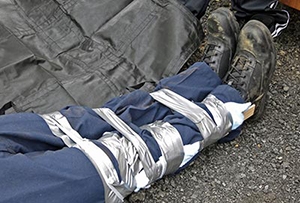

Two solid sticks and duct tape protect and stabilize a broken or sprained leg or ankle. One thing to keep in mind is that, since it can be very uncomfortable, you should avoid letting the duct tape or sticks come into direct contact with the skin.
14: Snow goggles
To build a robust “ribbon,” layer multiple pieces of duct tape. To make slits that line up with your eyes, determine how far apart your eyes are and cut out two very small rectangles in the ribbon. Place the ribbon over your eyes as if you were Zorro, Robin, or the Lone Ranger, and hold the ribbon to your head, you guessed it, with more duct tape.
15: Secure window glass


You may put duct tape over a pane of glass in a criss-cross star pattern to help reduce the risk of injury from fragments of glass. The duct tape will help keep the fragments of glass together if the window breaks. Instead, duct tape may also strengthen and hold glass fragments that are already broken.
16: Firestarter


Duct tape burns very well and works as a suitable replacement for char fabric. Only strip as many thin strips as possible of a piece of duct tape and ball it together to make the classic “bird’s nest ball” of tinder that will burn for a few minutes.
Related: How to Start a Fire Flint and Steel Vs Ferrocerium
17: Lashing
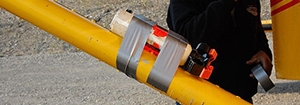

When rope is unavailable, duct tape can usually be used for lashing objects securely together.
18: Help avoid blisters
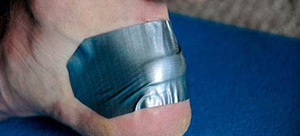

For areas of skin that are prone to getting blisters, such as the bottom of your foot or heel, proactively place a piece of duct tape over the affected area to provide an extra layer of protection from blister-causing fiction.
19: Ankle or wrist brace
You can use duct tape applied over a layer of fabric to construct an ankle or wrist brace if no ACE or similar medical bandage is available. To reduce the movement in the joint, avoid wrapping the tape too tightly and use enough to provide some mild resistance.
20: Seal ammo boxes
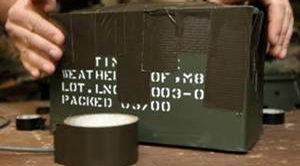

One of the initial applications of duct tape was during World War II to waterproof ammunition boxes.
This is how it was achieved by the Greatest Generation, and it turned out pretty well.
21: Repair glasses
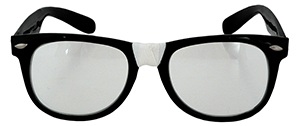

Do you remember those dorky TV characters or movies that wear glasses keeping duct tape together? If you need to hold the broken glasses together, you can do that, too. It’s not going to look great, but it’ll work.
22: Fly tape
Take a duct tape two foot strip and cut it lengthwise so that it’s around 1 inch in width. Stick one end, like a door jamb or overhead branch, to an elevated point, and the bottom end to a weight, like a small rock. It’s not going to perform as good as real fly tape, but it’s free of chemicals and odor and won’t draw unwanted attention.
23: Make a spear
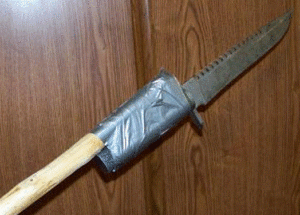

You have yourself a spear when you tie your survival knife to the end of a pole or stick with the liberal use of duct tape to prevent it from moving.
When things get rough, this can provide an excellent standoff tool.
Related: 8 Items You Need To Bring if You Need To Leave In 10 Minutes
24: Restraints
To keep them restrained, duct tape may be placed around the ankles and/or wrists of a person. In a survival scenario, the need to restrain another person is probably not possible, but it’s a possibility. The normal survival kit, after all, is unlikely to have handcuffs.
25: Vehicle repairs


Duct tape is perfect for your vehicle’s makeshift repairs. Duct tape is completely capable of keeping pieces together to cover up gaps or cracks. Since the Apollo 17 crew used duct tape to patch their moon rover, this should come as no surprise.
Related: Five Emergency Survival Tools
26: Make a Wallet
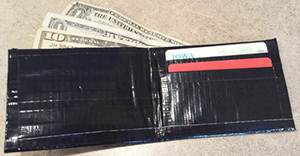

Everyone wants a wallet, right? Whether you’re truly a stubborn do-it-yourselfer or you have a taste for the unusual, then pull out that roll of duct tape and make your own wallet!



